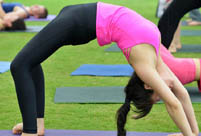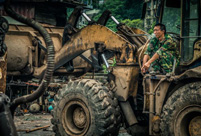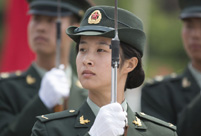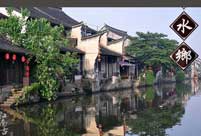 Chinese Kung Fu charms Silicon Valley
Chinese Kung Fu charms Silicon Valley
 Tranquil Yankou ancient town
Tranquil Yankou ancient town
 Lake Geneva: A show of swans
Lake Geneva: A show of swans
 Beautiful sunset over the Irtysh River
Beautiful sunset over the Irtysh River
 Qingjing Mosque: Witness of the ancient Maritime Silk Road
Qingjing Mosque: Witness of the ancient Maritime Silk Road
 Neiliansheng – more than 100 years of fashion
Neiliansheng – more than 100 years of fashion
 Golden retriever feeds baby African lions
Golden retriever feeds baby African lions
 Strange rocks in Lama Mountain
Strange rocks in Lama Mountain
 First overseas "China-standard" electric railway laid
First overseas "China-standard" electric railway laid
 College graduate launches organic agricultural cooperative in hometown
College graduate launches organic agricultural cooperative in hometown"You blood pressure is a little too high. You need to adjust your diet and at the same time take some hypertension drugs," said the doctor, greatly easing the mind of Zhaxi, a resident of Liuwuxincun Village, Liuwuxinqu District, Lhasa, who had worried about his health for long. Upon receiving some hypertension drugs handed out by the doctor, Zhaxi emotionally said, "I don't have time to go downtown to see a doctor. It is indeed unexpected treatment that doctors will come from downtown to us ordinary people and give us free drugs. We are grateful to the Communist Party of China and the government."
In Lhasa, many of the local people, particularly those in need, lack medical and health-care knowledge, as they seldom care about their own health. Some people even have never received a physical examination in their entire lives, which makes it possible for minor ailments to develop into serious diseases. In light of this problem, since 2010, Lhasa has offered regular physical examinations to the masses and provided a safety net for their medical well-being.
Care for the children, bring love to every child
The children determine China's future and caring for their health amounts to caring for China's future. Among 12 welfare programs launched in 2012 by the Municipal Party Committee and People's Government of Lhasa is an effort to offer a free physical examination to children aged below 6 and establish a health record for each such child.
According to Director of the Health Bureau of Lhasa Zhaxideji, since March 25, 2012, the bureau has been conducting a survey of children aged below 6 within its jurisdiction by putting together a team of experts, who have decided to include in the proposed free physical examination 6 items, including nutritional status, congenital heart disease, liver and lung functions, and skeletal development. At present, the implementation of the free physical examination is under way in an orderly manner across the city.
The unique natural conditions of Tibet expose the children there to a much higher incidence of congenital heart disease. To Damxung County, a region of a rather high altitude, a team of medical professionals was sent to examine the local children for congenital heart disease. A long line of children formed at the door of the screening room wherever they went. A boy named Zhaxijibu, who also had a 6-year-old sister and a 3-year-old brother, came from a family supported solely by a father who suffered slight cataract in one of his eyes and worked as a carpenter. Zhaxijibu and his siblings were thin and in black shape. Everybody's heart sunk when it was found after a preliminary examination that Zhaxibuji might have the disease. Upon a more thorough examination, however, Zhaxijibu was found to have a healthy heart. His father was greatly relieved to hear the good news, and said to the doctors in gratitude, "Yaqiong! Yaqiong!"
Care for the middle-aged and aged, bring love to everybody
In recent years, Lhasa has been providing physical examinations for farmers and herdsmen aged above 45 by sending out various sorts of medical teams, a popular move widely appreciated by the masses. Up to now, Lhasa has begun to provide free examinations for its registered residents aged 45 and above and establish a health record for every such person, and as a result a total of 59,806 persons, or 94.08% of that age group, have been examined. It is fair to say that the people of Lhasa enjoy good health and services and effective medical assistance.
To better serve its people, Lhasa has formed teams of examination experts by choosing from the elite medical professionals of Tibet armed police general hospital, Tibet Military Region General Hospital, and Lhasa People's Hospital. These teams travel across Lhasa in its entirety, which consists of 7 counties and 1 district. They provide careful diagnosis and medical services for every Tibetan who comes to get a physical examination or have their disease cured, and give the patients repeated instructions as to how to take the drugs and what precautions to take.
The health of the masses is what any such team cares about most, and the team members are willing to serve despite huge effort and hardships, so long as they can relieve them of their diseases. Luodan, a 66-year-old Tibetan from Qilang Village, Zhaxue Township, Maizhokunggar County, had suffered from a heart condition for long and had been unable to receive necessary treatment due to circumstances beyond his control. Upon learning of his problem, a team of medical professionals happening to offer examinations in the county immediately sent a small team to his home in defiance of serious difficulties arising from high-altitude anoxia. Upon inquiring about his condition, the team leader Wu Qiao made a careful diagnosis and gave Luodan some free drugs, repeatedly advising him to pay attention to his diet and try to undergo surgery as soon as possible. As the small team was about to leave, Luodan, holding the hands of its members, said excitedly to them, "Jinzhumami, Yagudu! We will live a long life because of you!"
Care for the monks and nuns, bring medical services to every monastery
Early on the morning of May 7, 2012, there already were over 100 monks and nuns waiting to be examined at the physical examination center on Floor 4 of Lhasa People's Hospital. Unlike any previous examination, every monk or nun held a form titled "Physical Examination Form" in his hand. Among the monks and nuns, Lama Silangwangjie from Ramoche Monastery, who had long suspected an eye problem, was now receiving a vision examination. He was relieved when it was announced that both his eyes had perfect vision.
According to Danzengouzhu, director of the medical affairs office of the hospital, this examination included many items, like blood pressure, heart rate, vision, chest fluoroscopy, liver function, etc., that fall into such categories as internal medicine, surgery, gynecology, and otolaryngology, designed to produce a full picture of a monk or nun's health status.
Providing physical examinations for Tibetan monks and nuns is a major welfare program jointly launched in 2012 by the Regional Party Committee and People's Government of the Tibet Autonomous Region. As the center of Tibetan Buddhism, Lhasa abounds in temples and monasteries. To promote the implementation of the program, Municipal Party Secretary of Lhasa Qi Zhala held several meetings attended by relevant municipal authorities, ordering that arrangements be made for physical examinations to be given to monks and nuns across the city and that "Lhasa take the lead in the broad effort across the entire autonomous region to provide physical examinations for monks and nuns."
Starting May 2012, Lhasa began to offer its registered monks and nuns free physical examinations and establish a health record for each of them. Through unceasing effort by its huge group of medical professionals, Lhasa completed the task within a mere two weeks, resulting in 97% of all registered monks and nuns being given an examination. As a follow-up, Lhasa offered physical examinations to the remaining 3%, who had failed to show up for an examination due to various reasons to ensure that all of its registered monks and nuns had received an examination.
Awangdongjue, a monk from Drepung Monastery, was 56 years old. He said that the monks and nuns had been enjoying better and better medical services in recent years. No physical examination system had been established before due to limited resources. From now on, the monks and nuns will be given a free examination once a year, with a view to detecting any medical condition in time and giving treatment accordingly. This will benefit their health a great deal. (Genduo)
 Opening ceremony of 67th Cannes Film Festival
Opening ceremony of 67th Cannes Film Festival Pulse of Xiamen - Int'l Yoga art festival in May
Pulse of Xiamen - Int'l Yoga art festival in May Photo story: Life of a scrap metal recycle worker
Photo story: Life of a scrap metal recycle worker Training of the PLA's first female honor guard
Training of the PLA's first female honor guard China's 10 must-see animations
China's 10 must-see animations Female bodybuilders show their beauty of fitness
Female bodybuilders show their beauty of fitness A taste of Harbin cuisine
A taste of Harbin cuisine A bite of Jiang Nan
A bite of Jiang Nan Who is China's campus beauty queen?
Who is China's campus beauty queen? 8 great movies to watch with your mom
8 great movies to watch with your mom China's most luminous celebrities
China's most luminous celebrities Newly recruited police in Hetian hold drill
Newly recruited police in Hetian hold drill  Bird-men compete flying in Hong Kong
Bird-men compete flying in Hong Kong  The 'Chinese Dad'
The 'Chinese Dad' Shanghai locals bid farewell to childhood memories
Shanghai locals bid farewell to childhood memoriesDay|Week|Month